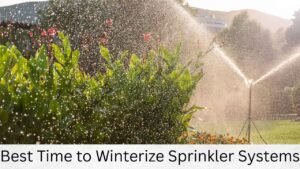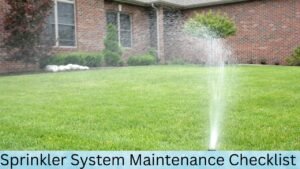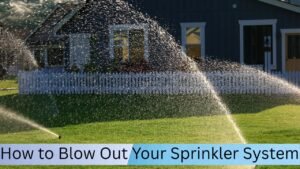Maintaining a sprinkler system year-round is essential to ensuring your lawn stays healthy and green. Whether you’re new to sprinkler maintenance or a seasoned homeowner, following a detailed schedule can help you avoid costly repairs and water waste. This comprehensive guide will walk you through each month’s maintenance tasks with practical tips, common issues to look out for, and troubleshooting advice. From the icy winters to the scorching summers, we’ll cover everything you need to keep your system running smoothly.

Quick Reference: Monthly Sprinkler Maintenance Tasks by Season
| Month | Maintenance Task | Common Issue to Look For | Tools Needed |
|---|---|---|---|
| January | Check system for winter damage | Frozen pipes or broken sprinkler heads | Pressure gauge, flashlight |
| February | Inspect all sprinkler heads | Misaligned spray patterns | Adjustable wrench, nozzle cleaning tool |
| March | Initial system inspection & calibration | Dry spots or over-watering areas | Pressure gauge, small shovel |
| April | Adjust watering schedule for spring growth | Uneven water distribution, clogged nozzles | Pressure gauge, sprinkler head wrench |
| May | Check and clean sprinkler heads | Clogged nozzles, debris in filters | Nozzle cleaning tool, gloves |
| June | Inspect water pressure and adjust system | Low water pressure, leaks | Pressure gauge, leak detection spray |
| July | Test sprinkler zones, adjust settings | Spray pattern issues, dry patches | Pressure gauge, zone tester |
| August | Inspect system for clogs and leaks | Clogged nozzles, misdirected spray | Cleaning brush, leak detection spray |
| September | Perform a mid-season check-up and recalibrate the system | System not reaching all areas, poor coverage | Pressure gauge, sprinkler head wrench |
| October | Winterize system (if necessary) | Frozen pipes, water damage | Air compressor, valve covers |
| November | Final inspection and winterization preparation | Frozen components, debris in pipes | Air compressor, covers, insulated tape |
| December | Review system’s overall performance and prepare for next year | Low efficiency or leaks from wear and tear | Pressure gauge, flashlight |
In youtube video below: Sprinkler Talk #23 – Sprinkler Testing & Maintenance Routines by Project Fire (YouTube, 10 Dec 2020), the importance of consistent inspection and upkeep is clearly explained. Regular testing not only ensures compliance but also keeps sprinkler systems dependable when emergencies strike.
January – Check System for Winter Damage
Goal: Ensure your system is intact after the harsh winter conditions.
Winter can cause significant damage to your sprinkler system, especially if pipes or sprinkler heads are exposed to freezing temperatures. Common issues to look for include frozen pipes, cracked sprinkler heads, and valves that may have been damaged by the cold.
How to Check: Start by inspecting all exposed pipes for signs of freezing or cracking. Use a flashlight to look under any covers or valves for visible damage. If you’re in a region with freezing winters, consider installing insulation or valve covers to prevent future damage.
February – Inspect All Sprinkler Heads
Goal: Ensure spray patterns are correct and nozzles are free from debris.
After the winter thaw, it’s time to inspect your sprinkler heads. Misaligned spray patterns can lead to overwatering some areas and underwatering others, wasting water and hurting your lawn.
Common issue: Misaligned sprinkler heads or clogged nozzles.
How to Check: Look for areas of your lawn receiving too much water or patches that remain dry. If you notice spray hitting sidewalks or driveways, this is a sign of misalignment. You can adjust the nozzles using a wrench. Additionally, use a nozzle cleaning tool to remove any debris blocking water flow.
March – Initial System Inspection & Calibration
Goal: Prepare your system for the spring by ensuring everything is working properly.
As the weather warms, it’s time for your first full inspection of the year—follow this spring-fall sprinkler checklist to ensure you’re not missing anything critical . Common issue: Dry spots or over-watering areas, which might be caused by miscalibrated sprinkler heads.
How to Check: Run the system and watch for uneven water distribution. Check the pressure to ensure it’s within the ideal range for your system. Look for areas that receive too much or too little water. Adjust the controller as needed to balance the system.
April – Adjust Watering Schedule for Spring Growth
Goal: Set your system to meet the needs of new spring growth.
With the warmer temperatures, your lawn’s water requirements will begin to increase.
Common issues: Uneven water distribution and clogged nozzles can prevent your system from operating efficiently.
How to Check: Check the system’s pressure and ensure it’s not too high or low. Replace or clean clogged nozzles, and adjust the watering schedule based on the season. Spring typically requires more frequent watering than winter, but knowing when to start your sprinklers can make all the difference in avoiding overwatering early in the season.
May – Check and Clean Sprinkler Heads
Goal: Prevent water waste by keeping your sprinkler heads clean.
Over time, sprinkler heads can become clogged with dirt and debris, affecting their performance.
Common issue: Clogged nozzles leading to weak or uneven water distribution.
How to Check: Remove the sprinkler heads and clean them with a nozzle cleaning tool. Ensure no debris is obstructing the spray. While doing this, inspect for any cracks or signs of wear that may require a replacement.
June – Inspect Water Pressure
Goal: Ensure the system is running at optimal water pressure.
Water pressure plays a crucial role in your sprinkler’s effectiveness.
Common issue: Low water pressure can result in weak sprays and uneven coverage.
How to Check: Use a pressure gauge to test the pressure at the outdoor faucet nearest to the sprinkler valve. If the pressure is too low, you may need to adjust the system or check for blockages in the lines.
July – Test Sprinkler Zones
Goal: Ensure each zone is operating correctly.
By mid-summer, it’s time to check that your sprinkler zones are functioning properly.
Common issue: Dry patches or water pooling in certain areas due to faulty zone configurations.
How to Check: Test each zone individually to ensure water is being distributed evenly. If you notice that certain areas are dry, recalibrate the sprinkler heads to cover those spots. Additionally, check for leaks and repair them promptly.
August – Inspect System for Clogs and Leaks
Goal: Prevent any malfunctions during the peak of summer.
Your sprinkler system is working hard during the hot summer months, so it’s important to check for any clogs or leaks that could hinder performance.
Common issue: Clogged nozzles or misdirected spray.
How to Check: Inspect each nozzle for signs of clogging. If a nozzle is blocked, clean it using a nozzle cleaning tool. Additionally, check for any water pooling around sprinkler heads, which could indicate leaks. Fixing these early can save you water and money.
September – Perform Mid-Season Check-Up
Goal: Recalibrate your system to address any issues and prepare for fall.
Before the weather starts to cool, make sure your system is still running smoothly.
Common issue: Areas not being watered sufficiently, poor coverage, and failing heads.
How to Check: Test each zone again and recalibrate the sprinklers as needed. Check for any areas where coverage is poor and ensure all heads are properly positioned to reach their intended area.
October – Winterize System
Goal: Prepare your sprinkler system for freezing temperatures.
If you live in a region that experiences freezing temperatures, you’ll need to winterize your system to prevent damage—but is winterization worth hiring a professional? Here’s what you should know before deciding.
Common issue: Frozen pipes or cracked sprinkler heads.
How to Check: If you’re in a cold climate, blow out your system using an air compressor to remove any remaining water in the pipes. In milder climates, you may only need to drain the system and cover exposed pipes.
November – Final Inspection and Winterization Preparation
Goal: Perform a final check to ensure everything is ready for winter.
As temperatures continue to drop, complete your winterization and ensure your system is fully protected.
Common issue: Frozen pipes, debris blocking valves, or malfunctioning components.
How to Check: Inspect all pipes, valves, and sprinkler heads for any issues that might prevent proper winterization. Use insulated covers or blankets to protect exposed components from the cold.
December – System Review for Next Year
Goal: Review your system’s performance and plan for next year.
With the end of the year, take some time to evaluate how your system has performed.
Common issue: Low system efficiency or signs of wear and tear.
How to Check: Look at the overall performance of your sprinkler system and assess if any parts need to be replaced before the next season. This proactive approach will save you time and money next year.
Tips for Efficient Sprinkler System Operation
In Youtube video below: Mastering Sprinkler Irrigation: Tips for Optimal Operation and… by SwitchON Foundation (YouTube, 21 Feb 2022), practical strategies for running sprinkler systems efficiently are highlighted. Following these tips helps save water, reduce costs, and maintain healthy lawns and gardens year-round.
- Routine Checks: Visually inspect heads for cracks or damage every time you mow the lawn.
- Smart Controllers: These devices can save up to 50% of water usage by adjusting schedules based on weather conditions.
- Proper Adjustment: Always ensure sprinkler heads are correctly aligned to prevent water wastage.
Common Questions About Sprinkler Maintenance
Q: How do I know if my sprinkler system is working efficiently?
A: Check the water pressure, spray patterns, and ensure all zones are covered without over-watering any specific area.
Q: What should I do if I find a leak in my sprinkler system?
A: Turn off the water supply and inspect the system for damaged pipes or connections. Use a leak detection spray to locate the issue and repair it as needed.
Conclusion
Implementing this monthly sprinkler maintenance schedule will not only help you maintain a healthy, green lawn but will also reduce the risk of costly repairs down the road. Bookmark this guide and use it year-round to keep your system in top shape, ensuring maximum efficiency and water savings.





